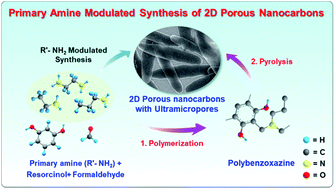Primary amine modulated synthesis of two-dimensional porous nanocarbons with tunable ultramicropores†
Abstract
Porous carbons with a two-dimensional (2D) morphology and narrow micropore size distribution can significantly enhance molecular separation efficiency. The precise control of micropore size is desirable; however it remains a big challenge as most reported carbon materials usually have non-uniform distribution of micropores. Herein, a group of 2D porous nanocarbons with single-sized ultramicropores was synthesized by relying on the polybenzoxazine chemistry using primary amines with various aliphatic chain lengths as the modulator. The unimodality of the micropore size of 2D porous nanocarbons depends on the length of aliphatic chains in the amine moieties. By pyrolysis of short chain amine induced polybenzoxazines, the produced 2D porous nanocarbons mainly consist of sp2 carbon, which leads to the stacking of crystallites in a nearly parallel orientation, resulting in the formation of unimodal ultramicropores. When evaluated as an adsorbent for CO2 capture, the 2D porous nanocarbons, with a high adsorption capacity (5.2 mmol g−1), an excellent selectivity (192) and fast sorption kinetics under ambient conditions, are complemented by the fact that equilibrium uptakes can be achieved in dynamic flow situations.



 Please wait while we load your content...
Please wait while we load your content...